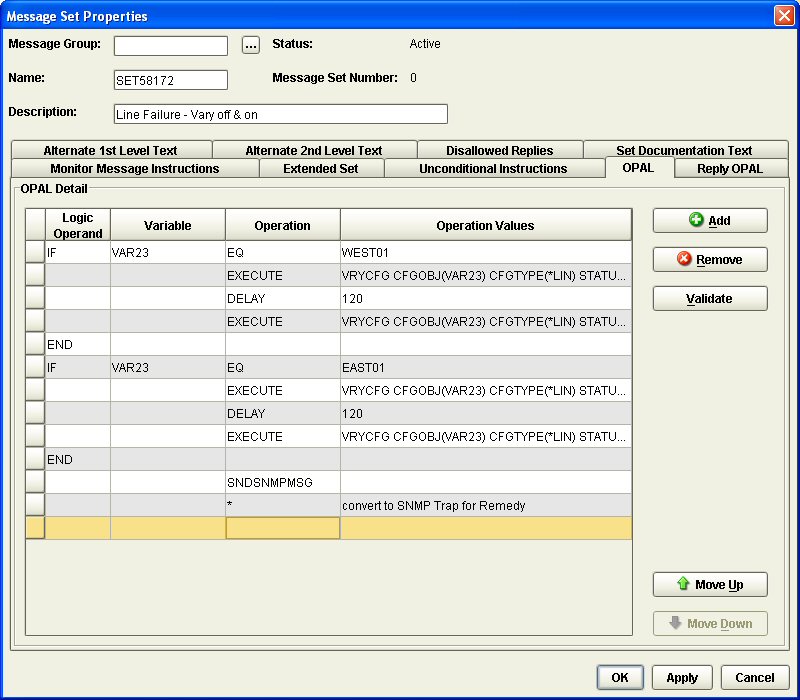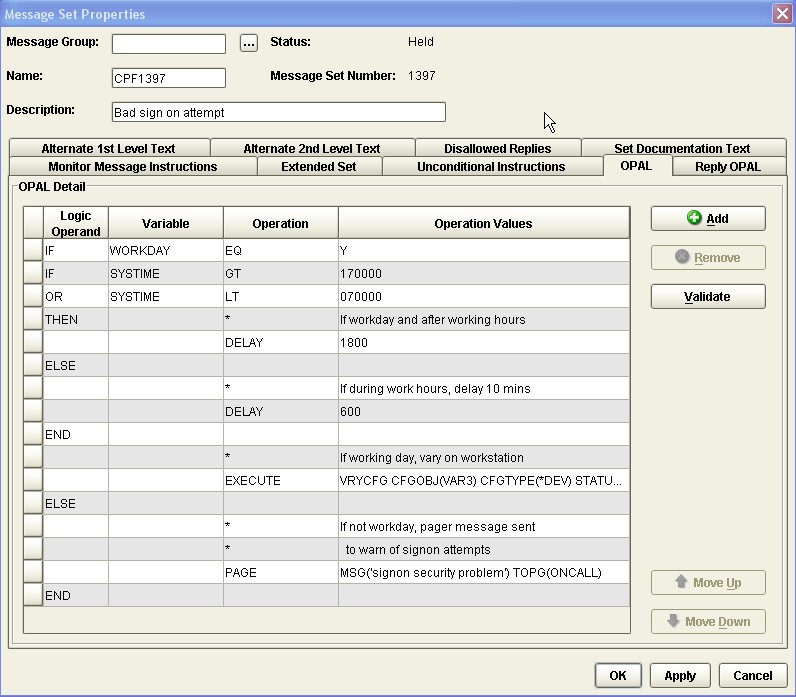How do you automate complex message-processing?
The System i QSYSOPR message queue, a chronological log of events from IBM i, contains a wealth of information. Application, storage, hardware, security, and systems management errors and other events are all posted to this queue. But more than 95 percent of these events may be unimportant "noise." And one of the most critical aspects of message automation is to "cut out the noise" by focusing on the important messages and ignoring the unimportant ones.
The problem is that a message, such as Job Ended Normally (CPF1241), may or may not be important based on many factors, including the content of the message and when it occurred. For example, if the job performing MQ Series on the system ends normally, you might want to know only if it ends during business hours. Or when certain backup jobs finish, you may need to notify the operations team with a confirmation message. And if certain jobs end abnormally, you might have to use SNMP to notify your enterprise management solution.
Robot/CONSOLE, the message management and resource monitoring software from Help/Systems, lets you "manage by exception" to automate your message processing on each System i or partition without programming. Robot/CONSOLE automates message events at the source of the problem. It uses your rules to suppress unimportant messages, change the color of messages, answer common messages, make messages response‑required, escalate messages, call programs, and execute commands.
OPAL Automates Conditional Processes
OPerator Assistance Language (OPAL) is Robot/CONSOLE's powerful operations language that helps you automate conditional message response procedures that usually require an operator's judgment. With OPAL, message automation is limited only by your imagination. Here are just a few examples of how you can respond automatically to messages using OPAL:
- File full--Respond based on which file is full and how many times the same file caused this message.
- Record lock--Respond based on the job that has the lock. After 10 failed attempts to release the lock, page an operator.
- Save-while-active--When this message arrives on the message queue, restart the interactive subsystem.
- User profile disabled--Activate the profile, but cause its password to expire so the user must enter a new password at the next signon attempt.
- Notify different application teams for the same message--Based on the user profile that generated the message, forward it to either the payroll group or the EDI (Electronic Data Interchange) team.
- Job ended normally--When a job ends normally, restart it during normal business hours, or send an email if it ends after hours.
- Job ends abnormally--When certain jobs end abnormally, use SNMP to notify your enterprise management software.
Using OPAL
Figure 1 shows an example of how to use Robot/CONSOLE OPAL to automate the response to a line-failure message. This response includes sending an SNMP trap for cross-enterprise notification.
Figure 1: OPAL lets you specify exactly how to handle a message. (Click images to enlarge.)
Figure 2 shows an example of using conditions--the time of day and the type of day (work day or other)--to control the rules that handle an event. Using the logic shown, the process for dealing with a failed signon attempt is handled automatically during normal business hours. But if the failed attempt occurs after hours, the system sends a pager message to indicate a potential security problem.
Figure 2: OPAL logic handles a failed signon attempt based on the time and day.
Learn more about Robot/CONSOLE by clicking here. You can even try it free for 30 days. And check out the other Help/Systems offerings in the MC Showcase Buyer's Guide.























 More than ever, there is a demand for IT to deliver innovation. Your IBM i has been an essential part of your business operations for years. However, your organization may struggle to maintain the current system and implement new projects. The thousands of customers we've worked with and surveyed state that expectations regarding the digital footprint and vision of the company are not aligned with the current IT environment.
More than ever, there is a demand for IT to deliver innovation. Your IBM i has been an essential part of your business operations for years. However, your organization may struggle to maintain the current system and implement new projects. The thousands of customers we've worked with and surveyed state that expectations regarding the digital footprint and vision of the company are not aligned with the current IT environment. TRY the one package that solves all your document design and printing challenges on all your platforms. Produce bar code labels, electronic forms, ad hoc reports, and RFID tags – without programming! MarkMagic is the only document design and print solution that combines report writing, WYSIWYG label and forms design, and conditional printing in one integrated product. Make sure your data survives when catastrophe hits. Request your trial now! Request Now.
TRY the one package that solves all your document design and printing challenges on all your platforms. Produce bar code labels, electronic forms, ad hoc reports, and RFID tags – without programming! MarkMagic is the only document design and print solution that combines report writing, WYSIWYG label and forms design, and conditional printing in one integrated product. Make sure your data survives when catastrophe hits. Request your trial now! Request Now. Forms of ransomware has been around for over 30 years, and with more and more organizations suffering attacks each year, it continues to endure. What has made ransomware such a durable threat and what is the best way to combat it? In order to prevent ransomware, organizations must first understand how it works.
Forms of ransomware has been around for over 30 years, and with more and more organizations suffering attacks each year, it continues to endure. What has made ransomware such a durable threat and what is the best way to combat it? In order to prevent ransomware, organizations must first understand how it works. Disaster protection is vital to every business. Yet, it often consists of patched together procedures that are prone to error. From automatic backups to data encryption to media management, Robot automates the routine (yet often complex) tasks of iSeries backup and recovery, saving you time and money and making the process safer and more reliable. Automate your backups with the Robot Backup and Recovery Solution. Key features include:
Disaster protection is vital to every business. Yet, it often consists of patched together procedures that are prone to error. From automatic backups to data encryption to media management, Robot automates the routine (yet often complex) tasks of iSeries backup and recovery, saving you time and money and making the process safer and more reliable. Automate your backups with the Robot Backup and Recovery Solution. Key features include: Business users want new applications now. Market and regulatory pressures require faster application updates and delivery into production. Your IBM i developers may be approaching retirement, and you see no sure way to fill their positions with experienced developers. In addition, you may be caught between maintaining your existing applications and the uncertainty of moving to something new.
Business users want new applications now. Market and regulatory pressures require faster application updates and delivery into production. Your IBM i developers may be approaching retirement, and you see no sure way to fill their positions with experienced developers. In addition, you may be caught between maintaining your existing applications and the uncertainty of moving to something new. IT managers hoping to find new IBM i talent are discovering that the pool of experienced RPG programmers and operators or administrators with intimate knowledge of the operating system and the applications that run on it is small. This begs the question: How will you manage the platform that supports such a big part of your business? This guide offers strategies and software suggestions to help you plan IT staffing and resources and smooth the transition after your AS/400 talent retires. Read on to learn:
IT managers hoping to find new IBM i talent are discovering that the pool of experienced RPG programmers and operators or administrators with intimate knowledge of the operating system and the applications that run on it is small. This begs the question: How will you manage the platform that supports such a big part of your business? This guide offers strategies and software suggestions to help you plan IT staffing and resources and smooth the transition after your AS/400 talent retires. Read on to learn:
LATEST COMMENTS
MC Press Online